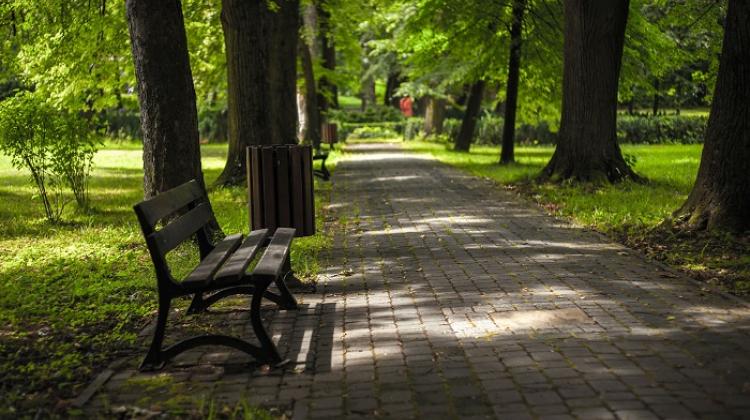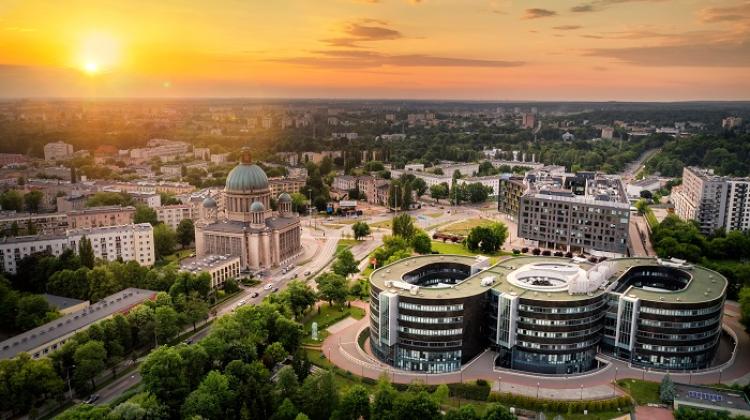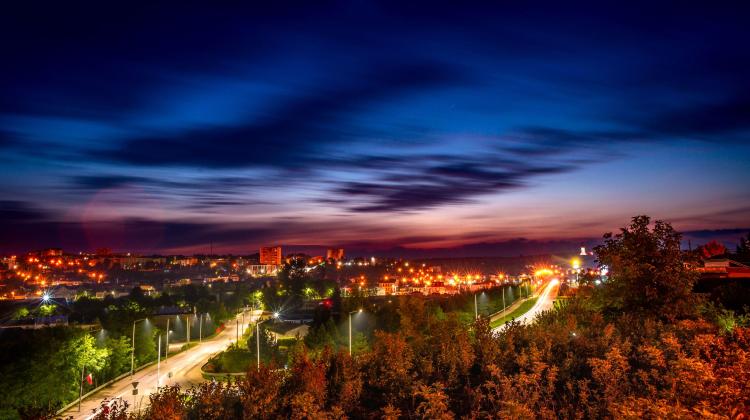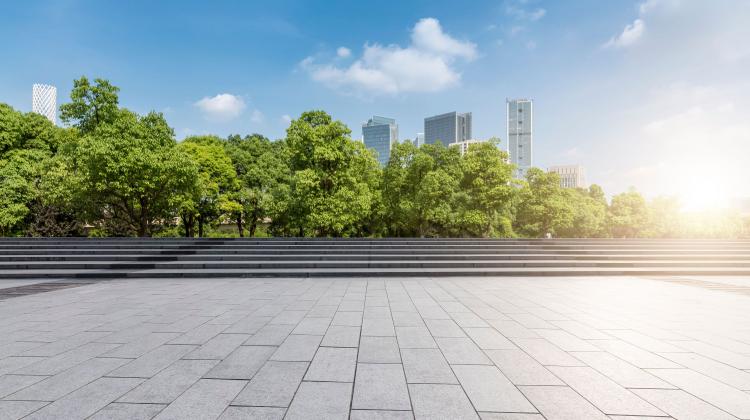Tree-mendous! City trees are green capital and make residents richer, says Warsaw economist
 Spring in a city park, AdobeStock
Spring in a city park, AdobeStock
The value of city trees and the benefits they bring to the public could be as much as PLN 1.8 million says a leading economist from the University of Warsaw, Dr. Zbigniew Szkop.
PAP: Economy and trees: what do they have in common?
Dr. Zbigniew Szkop, Assistant Professor at the Faculty of Economic Sciences at the University of Warsaw: In my opinion, these issues cannot be separated. Economics is often misunderstood: as the science of making money. Nothing could be further from the truth. Economics, according to its most popular definition, is the study the choices people make when they cannot have everything they want. Managing urban greenery, or more broadly - a city, is an economic problem. We have a limited space in the city that can be managed in various ways: we can create parks or build new shopping centres. Each decision has certain benefits and costs. Decisions should be made to best serve the residents, increase their well-being.
PAP: You are trying to appraise the services provided by trees. What specifically?
ZS: Urban trees provide a number of ecosystem services that my colleagues from the Faculty of Economic Sciences at the University of Warsaw and I have been appraising in our research for years. These include, for example, the provision of raw materials, such as timber or compost, regulation of the local and global climate, reducing rapid runoff of rainwater and the risk of flooding, improving air quality, improving the aesthetics of cities, and creating conditions for sports and recreation.
If the rates of fees for tree removal better reflected the real value of the services provided by trees, they could be a more effective tool for the protection of urban green areas
PAP: Why appraise it?
ZS: As I pointed out earlier, economics is the science of making choices. Everyone makes choices every day. Having a certain amount of money for going to the movies, we decide which movie we want to watch. Thus, we signal that watching a specific movie provides us with the most benefits, and on this basis, cinema managers can adjust the supply of that movie, for example by increasing the frequency of its screening. The situation is similar when it comes to urban management and decision-making regarding the maintenance of green areas. The difference, however, is that there is no market for urban greenery that would show how many benefits it provides for city residents. Without this knowledge, and having only the knowledge about the costs of maintaining urban greenery, irrational economic decisions may be made to eliminate urban greenery from certain areas. But the modern economy has methods that allow us to examine the value of services provided by urban greenery and show that urban greenery simply pays off.
PAP: How is it done?
ZS: While there is often no market for services provided by urban green areas to help determine their value, there are related markets that can provide this information. For example, there is no market for attractive looking trees, but there is a real-estate market. By using advanced econometric methods, we can investigate to what extent the vicinity of trees increases property values. There is no market for air purification by city trees. But we know that by purifying the air, city trees reduce the likelihood of contracting respiratory diseases, and we know the cost of treating these diseases. By combining this information, we can estimate how much we, as a society, are saving with this tree service.
PAP: In a 2021 study, you calculated that trees growing in Warsaw's Wola district provide an air purification service worth approximately PLN 16,000 annually.
ZS: The study covered over a thousand selected trees growing in Wola and showed that each year they remove about 450 kg of pollutants such as nitrogen dioxide (NO2), sulphur dioxide (SO2), as well as PM2.5 and PM10. Thanks to this action, they reduce expenses for hospital treatment and costs related to the repair of material damage, such as the destruction of building facades. The value of these benefits can actually be estimated at over PLN 16,000 per year. The study also showed that these trees sequester about 20 tons of carbon per year (they bind carbon from the CO2 present in the atmosphere in their tissues - PAP), and the value of this service is another PLN 9,000 per year. The total is approx. PLN 25,000 per year, and we are talking about only two selected ecosystem services.
PAP: A year earlier, as part of a National Science Centre grant, you estimated that by purifying the air, street trees growing in Warsaw generate benefits for society, the value of which can be estimated at approximately PLN 1.8 million (750,000 - 2.9 million) per year. That is impressive. Were you surprised by these results?
ZS: This result may actually be impressive, especially considering that the study concerned a selected 150,000 trees. Meanwhile, it is estimated that there are about 9 million trees in Warsaw. The results regarding the obtained value did not surprise me, they were consistent with the results of similar studies carried out in the past. Importantly, however, this study showed that the value of this service could be about two times higher for street trees than for other trees growing in a less polluted environment. So it is clearly worth it to plant street trees.
PAP: Does such research influence city authorities and their decisions regarding the management and protection of urban green areas?
ZS: I think that this type of research helps to raise the awareness of both decision-makers and city dwellers, who can then influence decision-makers from the bottom up. Of course, I do not know to what extent my research directly translates into shaping city policies, but I am pleased that, having read the results, some local governments asked for consultation and cooperation in implementing their ideas for greening cities, for example by removing impermeable surfaces and planting trees in their place.
PAP: What else can the knowledge of the valuation of services provided by trees be useful for?
ZS: This knowledge can be used, among other things, to develop a new method for determining the rates of fees for the removal of trees in cities. In my opinion, these rates should be linked to the knowledge of the value of the benefits provided by trees, and not set arbitrarily. If the rates of fees for tree removal better reflected the real value of the services provided by trees, they could be a more effective tool for the protection of urban green areas
PAP: Are economists dealing with the valuation of services provided by urban trees able to appraise all services related to the presence of trees?
ZS: I think it is impossible, if only because we are still learning about new benefits of urban greenery. For example, a recent US study showed that by purifying the air, urban greenery can also contribute to a more normal pregnancy development. Science continues to provide us with new knowledge. It will never be the case that we can say that we now know everything. For this reason, when interpreting the results, we should remembered that these are low estimates and the real value may be even greater.
PAP: Can we talk about the 'most valuable' services of trees? And if so, what are they?
ZS: The value of a given tree service depends on the place where the tree grows and the local conditions. For example, a shading service can be very valuable in an Australian city and have a low value in Oslo. However, based on a review of studies carried out for cities in our part of the world, we can generally assume that urban trees provide the most valuable benefits in terms of local temperature regulation, improving the aesthetics of cities and creating conditions for sports and recreation.
PAP: New research published in Environmental Research Letters shows that even scattered, individual trees in urban areas provide cooler evenings. Have you also taken such tree services into account in the previous valuations?
ZS: In fact, urban trees can very effectively reduce air temperature through shading and transpiration. The value of this service can be studied by showing, for example, how this reduction of air temperature reduces the use of air conditioning, and thus electricity consumption, in adjacent buildings. For example, a study that I carried out for the authorities of the city of Rzeszów in 2019 showed that certain individual trees growing there provide this service worth about PLN 60 per year.
PAP: The project, of which you are the leader, assumes the creation of a mobile application that will enable users to appraise the services provided by greenery growing in cities and towns in Poland. What will it involve exactly?
ZS: The application to be developed in the 'City tree services calculator' project will require the user to provide basic information about the tree, for example its species, circumference, whether it is a street tree; the city in which it grows, etc. Based on this information, the algorithm will estimate the value of some services provided by this tree those that can be reliably estimated without the need for more advanced analyses. The exact functionality of the application and the ecosystem services to be included will be determined in a consultation process with potential application users. These consultations have just started, so I encourage all those interested to contact me.
PAP: Who can find the application useful and what for?
ZS: The mobile application can be used, among others, by environmental educators, officials shaping urban greenery, employees of non-governmental organizations and other people interested in increasing the environmental awareness of the residents of Polish cities. It can be used as a tool in educational campaigns.
PAP: Would you say the richest cities are those that have the most trees?
ZS: City trees are green capital. It is safe to say that the trees in cities make their inhabitants richer.
PAP: What nature-based solutions should be used in urban areas to counteract the effects of climate change?
ZS: I think that, first of all, we should take steps to 'de-concrete' our cities, and then set up grassy areas, meadows, and of course plant trees in these places!
Dr. Zbigniew Szkop is an environmental economist. He works as an assistant professor at the Faculty of Economic Sciences of the University of Warsaw, and an expert at UNEP/GRID-Warsaw Centre. He conducts scientific research and promotes knowledge about the economic value of ecosystem services provided by city trees. He is also the author of the website www.ekonomiadlasrodowiska.pl and head of the National Centre for Research and Development funded research project carried out at the Faculty of Economic Sciences of the University of Warsaw entitled 'City tree services calculator'. As part of this project, a mobile application is being developed that will allow its users to appraise certain services provided by city trees. Dr. Szkop's contact information: zszkop@wne.uw.edu.pl
PAP - Science in Poland, Anna Mikołajczyk-Kłębek
amk/ zan/ kap/
tr. RL
Przed dodaniem komentarza prosimy o zapoznanie z Regulaminem forum serwisu Nauka w Polsce.


















